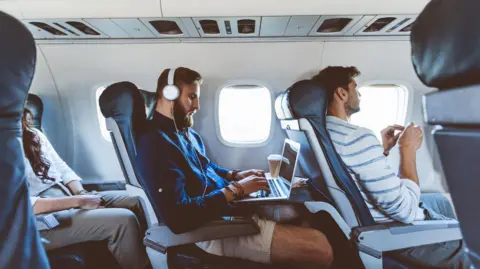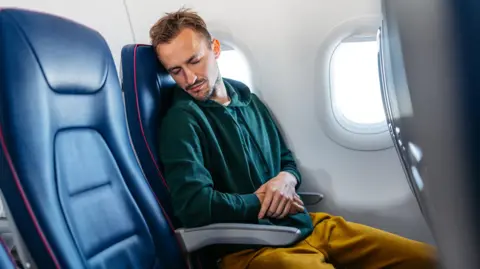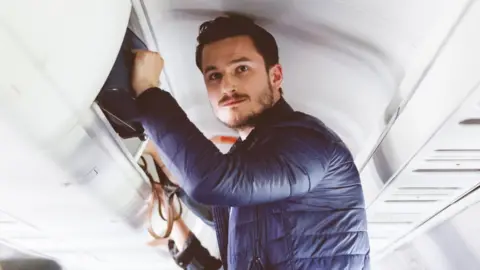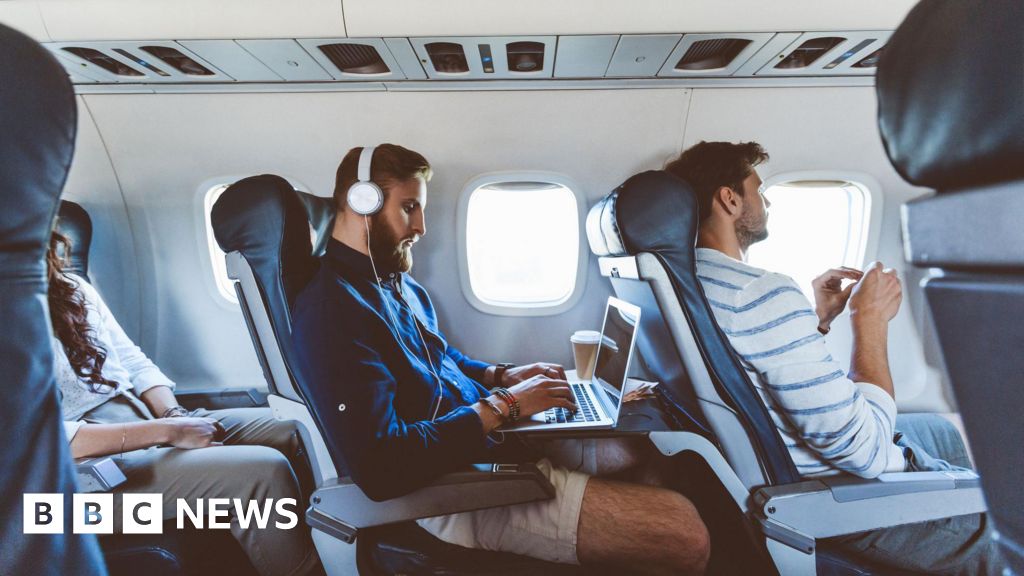 Getty Images
Getty ImagesA lot of us have been there, locked in a metal cylinder flying at more than 500mph (804km/h), gritting our teeth about the armrest the person to the left is hogging.
Or the person next to the window who keeps getting up to go to the toilet, or the person in front who has suddenly put their seat back, squashing your knees.
With roughly half of the UK’s households flying once a year, how people behave on planes is an ongoing bugbear.
And this week a Hong Kong couple were banned by Cathay Pacific after tensions flared over a reclined seat.
So how can we avoid getting in our fellow travellers’ bad books?
To recline or not?
Someone putting their seat back on a long-haul flight can be frustrating – but it seems to trigger Britons and Americans to different degrees.
A 2023 survey by Skyscanner into the issue indicated that 40% of people in the UK find it annoying at any one time, but a YouGov survey earlier this year suggested that only a quarter of Americans view it as unacceptable.
Whatever the percentage, reclining seats “really are a problem”, according to Charmaine Davies, a former flight attendant.
She says cabin crew sometimes have to step in to stop anger boiling over between passengers.
The basic problem is how airlines cram seats onto planes, according to Prof Jim Salzman of University of California, Los Angeles. “[The airlines] are able to pass on the anger and frustration of cramped seating to passengers who blame each other for bad behaviour instead of the airlines who created the problem in the first place.”
William Hanson, an etiquette coach and author, says it’s a matter of choosing your time to recline your seat, which you shouldn’t do during a meal. Check whether the person behind is leaning on the table, or using a laptop – and recline slowly.
If in doubt just talk to your fellow passenger, he says. Don’t expect them to be a mind reader.
Armrest hogging
 Getty Images
Getty ImagesAnother gripe linked to the amount of space people have on planes is double armrest hogging.
Mary, a flight attendant for a major US airline, says she is often given a middle seat between “two guys with both their arms on armrests” when she’s being transferred for work and doesn’t have a choice of seat.
Nearly a third of UK airline passengers found this annoying in 2023, the Skyscanner survey suggested.
Mary has had “a tussle with elbows”, she says, but has a strategy for reclaiming the space.
“I wait until they reach for a drink and take the armrest. One [guy] kept trying to push my arm, and I just had to give him a look: ‘We’re not doing that today.'”
To resolve any tension, Mr Hanson says people should get used to the idea of having “elbow rests” rather than armrests, and share them.
Toilet etiquette
Many of us will be familiar with the dilemma of being in a window seat and needing to go to the toilet, but the person next to you has fallen asleep.
Do you nudge them to wake them up, or climb over them?
More than half of Americans responding to the YouGov survey said having to climb over someone in the seat next to them to go to the toilet was unacceptable.
Mr Hanson says he normally has an aisle seat, and before going to sleep he tells the passenger next to him it’s fine to wake him up or hop over if they need to.
If sat in the middle or window seat, you should just gently let the passenger in the aisle seat know you need to get past them – but be aware you might not speak the same language, he advises.
If a passenger has been drinking alcohol, it can make them need to go to the toilet more often too.
Zoe, a former flight attendant with Virgin Atlantic, was on a flight to Ibiza on a different carrier where many of the passengers had been drinking in the airport bar beforehand, she says.
As soon as the flight took off and the seatbelt light went off, “everybody stood up” and started queuing for the toilet. Some got “quite aggressive”, she says, leading to the cabin crew turning the seatbelt signs back on, forcing everybody to sit down.
Unfortunately, one passenger really couldn’t wait so had to “have a wee in a carrier bag”.
“He put some swimming shorts in there first to soak it up,” says Zoe.
Standing up
 Getty Images
Getty ImagesAbout a third of Brits find people standing up as soon as the plane lands annoying, the Skyscanner survey indicated.
“Just stay in your seat,” says former flight attendant Ms Davies. “There’s no point jumping up because you’re not going anywhere.”
It normally takes the ground crew several minutes to either hook up the passenger boarding bridge or put boarding stairs in place.
Even after that, if you have checked baggage, you’re going to need to wait for it to get to the carousel, she says, “no matter how quickly you get off the plane”.
Mr Hanson says that in etiquette terms, there’s nothing wrong with wanting to get up to stretch your legs, and perhaps people just want to get off because they are unconsciously a bit scared of being on a plane.
But he adds that it is “faintly comical” when people all get up at once and then “stand there like a lemon”.
How can we get along?
Other air passenger pet hates include people jumping queues, using phones or other devices without headphones, draping long hair over the backs of seats, and taking shoes or socks off on a plane.
If you become aware the flight attendants are using spray to “spritz” the aircraft near you, you may want to put some socks or deodorant on, Mary says, as cabin crew won’t say anything directly.
But with air travel continuing to grow, how can we get on with other passengers on planes?
The key is everyone being considerate, Mr Hanson says.
“If you don’t want to temper your behaviour to get along with other people then there’s something wrong with you, to be blunt.”



